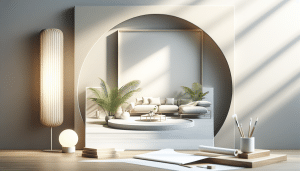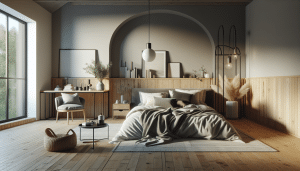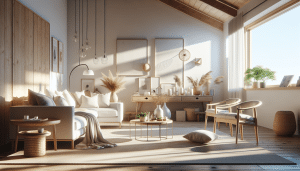Secrets to Creating a Cozy Minimalist Home
Samantha Lee September 24, 2025
Curious about transforming your space into a calming retreat? Discover how the cozy minimalist home approach lets you combine comfort with a clean, uncluttered style. This article explores practical steps, creativity tips, and real-life insights into making every room quietly inviting.
Understanding the Cozy Minimalist Aesthetic
The cozy minimalist home trend has gained popularity for those seeking a blend of simplicity and warmth. At its core, this design philosophy embraces open spaces, functional furniture, and soothing colors, while adding layers of comfort through textures and soft lighting. It’s not just about having less. It’s about making mindful choices—keeping what matters most and arranging it beautifully. This style allows for stress-free living and a visually restful environment, which can positively influence mood and daily routines.
Minimalism traditionally focused on stark, stripped-back rooms. Cozy minimalism, however, softens that rigidity by welcoming plush throws, natural fibers, and layered rugs. The approach is adaptable—whether you dwell in a city apartment or a suburban house. Striking the right balance starts by decluttering, but also by investing in pieces that inspire comfort and contentment. For many, it means displaying only a few cherished items, like a favorite vase or artwork, rather than filling shelves with objects that hold little meaning. This makes each room feel intentional and personal.
Expert designers suggest cozy minimalism suits anyone craving calm in an overstimulated world. Unlike purely minimalist interiors that can seem cold, this trend brings emotion and everyday usability into focus. Simple lines coexist with soft couches or handmade ceramics. The overall effect? A space that looks refined but never feels barren. This style provides the chance to highlight quality over quantity and supports sustainable living through thoughtful consumption. The possibilities within a cozy minimalist home are as varied as the personalities that inhabit them.
Decluttering for a Calm Foundation
Decluttering lies at the heart of creating a cozy minimalist home. Start by evaluating each room with a fresh perspective; ask what objects serve a true purpose and what can be donated or stored. Try the one-room-at-a-time method. Remove everything from surfaces, then selectively bring back items that offer utility or genuine joy. This not only reduces visual noise but can also clear mental clutter, fostering a sense of relaxation whenever you walk through the door. The process might feel daunting, but small, consistent actions yield real results.
Sorting possessions can stir memories and emotions. Many find it helpful to list essential categories—for example, books you revisit, family photos, or functional décor like lamps. Store or recycle what no longer fits. Consider the popular ‘one in, one out’ rule to prevent clutter from returning. Multi-purpose furniture, such as storage ottomans or fold-out desks, can help manage belongings discreetly. Over time, fewer objects make cleaning and tidying much easier, and help you notice the beauty of just a few meaningful things in a room.
Decluttering is also about letting go of guilt over items rarely used. Sustainable living aligns naturally with the cozy minimalist home idea, as both promote conscious consumption. Donate, sell, or recycle gently used furniture and décor. This approach benefits others in the community and can add to a shared sense of wellbeing. The result is a refreshed space that feels expansive, supportive, and welcoming, even if it’s compact. Decluttered rooms showcase design details and textures that might otherwise be overlooked.
Layering Textures for Warmth and Depth
Texture is the secret to turning minimal décor into a cozy retreat. Even the most pared-down room benefits from warm throws, nubby pillows, or woven baskets. Mixing materials like wool, cotton, linen, and jute prevents the space from feeling flat. Picture a neutral-toned sofa with a chunky blanket or smooth ceramic vases grouped together on a simple shelf. Lighting also plays a major role—opt for soft-glow lamps or candles to further add sense of comfort and intimacy to your cozy minimalist home.
Natural elements such as wooden side tables, stone planters, or potted greenery introduce organic interest without cluttering focus. Arrange textures deliberately—for instance, use a plush rug underfoot with sleek curtains above. Let every material contribute to the overall relaxing theme. Some designers recommend a palette of calm, muted colors that invite mindfulness and reflection; even whites, greys, and taupes can feel inviting when paired with soft, tactile accessories. It’s all about layers.
Small touches can make a significant impact. A cozy minimalist home doesn’t rely on luxury or excess; it thrives on thoughtful details. Try adding tactile experiences, like a hand-knit cushion against a smooth leather chair, or textured wall art that invites touch. These layers offer warmth and individuality, ensuring that ‘minimal’ never means boring. Harmony between simplicity and comfort is achievable through texture, making your home a place of daily renewal.
Choosing Functional Pieces with Personality
In cozy minimalism, every piece earns its place. Furnishings should be beautiful, but also practical. When shopping, prioritize items that serve clear purposes—a streamlined dining table for meals and gatherings, a bed with under-frame storage, or a bench that doubles as a coffee table. Avoid overcrowding; instead, let each selection contribute both style and utility. The right piece can serve many needs over years, blending seamlessly into shifting tastes and uses.
Personality shines through even in minimal décor. Rather than buying many trendy decorations, select objects with meaning or history: a family heirloom, a handcrafted lamp, or an artisan vase. These act as visual anchors in a spare setting and express unique stories about the people living there. Visitors to a cozy minimalist home often comment on the peace and intentionality that’s felt from the moment they step inside. It’s a reminder that the most inviting interiors reflect the real lives of their inhabitants, not a catalogue page.
Adaptability defines the best minimalist furniture. Pieces that transform for different occasions—like extendable tables or modular shelves—support changing needs as families grow or hobbies develop. Avoid complex gadgets that can complicate daily routines. Instead, let form and function guide choices. By focusing on multi-use design, the home remains organized, flexible, and appealing without being busy. Functional pieces with personality give rooms soul, establishing a warm sense of place within each uncluttered space.
Illuminating Your Space for Comfort
Lighting can entirely change the mood of a cozy minimalist home. Sufficient illumination, layered for different occasions, creates ambiance and enhances design details. Try mixing ceiling lights with floor and table lamps for flexibility. Diffused light highlights texture and helps rooms feel more inviting, while dimmers allow for instant adjustment between bright workspaces and restful retreats. Prioritize bulbs with warm tones instead of harsh, cold light, for spaces you’ll love spending time in.
Natural light is a minimalist’s ally. Maximize window space by keeping treatments simple—sheer curtains or light blinds maintain privacy without blocking sunshine. Arrange mirrors strategically to reflect daylight deeper into rooms, making even small or north-facing areas feel more spacious. Some homeowners install skylights or widen existing windows as part of their minimalist renovation. Plants near windows benefit from the natural glow, tying together calm tranquility and biophilic design trends.
Layering artificial light completes the cozy effect at night. Adjustable lamps on bookshelves or bedside tables serve as both practical and decorative elements. Task and accent lighting—such as a reading sconce in a favorite chair or twinkle string lights tucked onto a headboard—offer a sense of comfort that overhead lights miss. This attention to lighting may seem subtle, but it quietly transforms how every room is experienced, day or night.
Personalizing the Minimal Look
A minimalist home can be deeply personal, not sterile. The key is thoughtful curation. Show off a curated bookshelf, a handmade quilt, or black-and-white photographs that evoke memories. Avoid overcrowding, but don’t shy away from proudly featuring a few favorite things. This gives the entire home narrative and life, distinguishing it from impersonal, showroom minimalism. Replace quickly outdated trend pieces with artwork, plants, or family mementos to keep the focus intimate and meaningful.
Plants and greenery do more than clean the air—they offer motion, color, and a connection to nature. Even in the most streamlined environment, a few leafy accents soften straight lines and introduce visual delight. Art is another way to bring personal touches: one statement canvas can set the room’s tone. Rotate favorite items seasonally or as inspiration strikes. Your cozy minimalist home should evolve and adapt as you do, while remaining your retreat from the world.
Minimal doesn’t mean dull. By weaving in playful or sentimental accents—like a colorful mug on an otherwise neutral shelf or a small handmade sculpture—you highlight what matters most. The process is ongoing. Live with your space, observe what makes it feel genuine, and make edits over time. Creating a cozy minimalist home is a journey in self-discovery, as much as it is about beautiful interiors. Celebrate the peace you build within your walls.
References
1. The Spruce. (n.d.). The Essential Guide to Cozy Minimalism. Retrieved from https://www.thespruce.com/cozy-minimalism-ideas-5198854
2. House Beautiful. (n.d.). Cozy Minimalist Style Is the Feel-Good Trend Any Home Can Try. Retrieved from https://www.housebeautiful.com/room-decorating/colors/a41420069/cozy-minimalist-style/
3. Better Homes & Gardens. (n.d.). How to Achieve a Cozy Minimalist Home. Retrieved from https://www.bhg.com/homekeeping/organization/declutter-your-home/cozy-minimalist-decorating/
4. Psychology Today. (n.d.). The Mental Health Benefits of Minimalism. Retrieved from https://www.psychologytoday.com/us/blog/compassion-matters/202103/the-mental-health-benefits-minimalism
5. Apartment Therapy. (n.d.). 8 Ways to Make Minimalism Feel Warm and Inviting. Retrieved from https://www.apartmenttherapy.com/minimalism-warm-inviting-decor-367373
6. National Institutes of Health. (n.d.). Creating Natural Light in Indoor Environments. Retrieved from https://www.ncbi.nlm.nih.gov/pmc/articles/PMC6462790/







